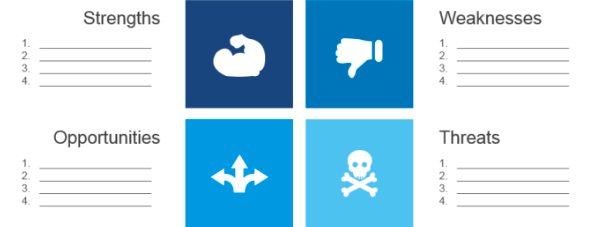
SWOT is a tried and true method for getting a better understanding of a company, but chances are that you’re doing it all wrong. SWOT is a way of analyzing a company by researching and understanding their strengths and weaknesses. You then compare their Strengths and Weaknesses to Opportunities and Threats in the marketplace to assess the company’s internal capabilities with external possibilities, hence the acronym, SWOT. The SWOT technique can be applied to more than just competitors. A SWOT analysis can give you great insights into suppliers, acquisition targets, partners, and even B2B customers.
Think about all the supply chain issues that have resulted from the COVID-19 pandemic. If a company had done a proper SWOT analysis on its key suppliers, they may have identified a lack of redundancy in their supply chain, too much concentration of their supply chain in a specific region or country, bottlenecks, or a whole host of other issues that could have better prepared them for a disaster like COVID-19. The same applies to acquisition targets, partners, and critical B2B customers. SWOT is a versatile tool that many of us should learn to use well.
A typical SWOT analysis is represented in a quadrant map or chart as in Figure 1. If you stop at this basic analysis, then you are missing out on insights that a properly done SWOT analysis can provide. Before we cover what is missing from this basic approach, we need to know how to gather reliable, useful data needed to perform a SWOT analysis in the first place. As the saying goes, garbage-in-garbage-out, and that applies to a SWOT analysis too. In this two-part blog series, we are going to discuss ways to get at solid, reliable data you need for a SWOT and how to properly execute a SWOT analysis so you end up with insights you can actually act upon.

Gathering Data for Your SWOT
Where would you start looking for information on a company? Was your first thought Google, or maybe the company’s website? Those initially come to mind for most of us. There is nothing wrong with these sources, but you’re not going to get a deep or broad perspective on a company by limiting yourself to them. There is no doubt that Google is an excellent search engine, but there is much content that Google doesn’t reach. Any information that is authored by a company is specifically tailored to deliver the message that the company wants the market to receive. Content published by a company may not have what you need or may be a version of the truth that is not useful to you.
For example, Facebook is an ads-based business. Its product is essentially you, the Facebook user (or at least your data). Facebook sells ads to companies that want to target you based on the data that Facebook has about you. But during the Facebook Cambridge Analytica scandal, Chief Operation Officer Sheryl Sandberg described Facebook’s use of your data as follows: “We’re selling the opportunity to connect with people, but it’s not for sale.” What in the world does that mean?
She went on further, “We’re using it to personalize your service. So let’s talk about the data you put on Facebook. So, one piece of data you put on Facebook is who you connect to and your friends. We show you, in your news feed, posts from people you’ve connected to. That’s how we’re using your data.” In her description, there is no mention of using your data to sell ads. Her description only talks about personalizing your service. Facebook doesn’t want regular users to think about the cold hard facts about their business, so they spin it.
The sources that you use to gather company information to use in a SWOT analysis must be balanced against your timeframe, budget, and the strategic importance of your situation. But more importantly, the information you use must be reliable and accurate regardless of the situation or its limitations.
Two Broad Categories of Information
In broad terms, you can divide sources of company information into two categories: worthless crap anyone can get from Google, and stuff so hot it must be illegal. Joking aside, the two general categories are actually known as published sources and field sources. Sometimes these are called secondary research and primary research. Published sources are just what they seem, information that is written and published about a company. Field or primary sources are people—people that have firsthand knowledge about the company of interest that you won’t find published anywhere. Sometimes you can limit yourself to published sources. In other situations, the intelligence you need might only be available from field sources, such as the launch timing of an anticipated new product.
Published Information
Not all published information is created equal. The open web is teeming with dubious, unverifiable, and even deceitful content as well as authoritative, data/science backed information from reliable sources. It can be a real task to verify the reliability of a source you’ve never heard of before.
When I start a company SWOT analysis, one of the first published sources of information I review is their presentations to investors and analysts. If a company is private, they won’t have such presentations, but public companies are required to communicate to their shareholders. These presentations are excellent sources of information about the performance, strategies, and plans of a company, just keep an eye out for the spin.
Stock analyst reports are another good source of company insight. These are reports written by stock analysts to help investors make decisions about buying, holding, or selling a company’s stock. This can be a good, independent, review of a competitor—free of the PR spin that you get from a company’s investor presentations. Sometimes you can get these reports from a company’s website. More often, you need to subscribe to a source that aggregates these reports and those can be quite expensive.
If you are more interested in the financial side of a competitor’s situation, then be sure to review their annual report and 10k. Company authored annual reports are usually full of a lot of fluff which is designed to hide negative information. Put your focus on the auditor’s report, notes to the financial statements, and the management’s discussion and analysis.
You will also need a good source of business news. Google will certainly work in this regard if you have nothing else, but there are other superior sources that aggregate many types of business news sources. Different news sources focus on different niches and have different features. If you need a good, comprehensive source of local, national, and international news then you’ll need access to a reputable business news aggregator. There are about 4 or 5 leaders in this area and all of them charge a premium.
There are many other sources of information you may need to tap to obtain reliable information you need about a company. Other sources include syndicated market research, patents, journals (business, sci/tech, scholarly, trade), conference proceedings, associations, directories, product launch databases, advertising spend databases, and many others. The amount of authoritative, reliable information about companies grows every day, as does, the dubious, unverifiable, and deceitful information. Figuring out how to approach the data gathering can leave you reeling. Separating the noise from the signal is a big challenge especially if research isn’t your specialty or the main focus of your job. You can easily waste an enormous amount of time hunting for information when what you should really be doing is applying it.
Field Data
The best field sources tend to be current and recent former employees of the company of interest. Beyond the company itself, there are many other field sources that can shed light on the company you are trying to assess. These include the company’s customers, suppliers, partners, distributors, and dealers. Beyond these sources, industry experts, consultants, and even academics can be great sources of insight about specific companies.
Customers can help you understand the experience the company delivers, their approach to sales, and performance of their products/services. If you are in a business-to-business (B2B) market, customers can shed light on a company’s proposals and service contracts. Suppliers shed light on types of parts, components, and materials competitors are buying. Dealers and distributors know about customer compliments and complaints, competitor market shares and growth (or contraction). They can also tell you the pros and cons of competitors’ dealer/distributor programs, and how that drives—or does not drive—dealer/distributor loyalty. Experts, consultants, and academics often have well-rounded perspectives of competitors. This group of field contacts are often well connected in the industry and can refer you to other good sources of information.
One of the big challenges of field sources is being able to track down and contact the people that can help you. This falls back to needing access to a broad and reliable source of published information sources that can help you track down the right people to talk to about a company.
Research Framework
You should also use a framework to guide your research effort. A framework ensures you are gathering all of the relevant information you need. It also standardizes your approach so you can readily compare companies on similar aspects. I like to use a modified version of the Ten Types of Innovation framework from Dobson as a starting point for my research categories on a company. This gives me a comprehensive set of categories to research on each company I’m interested in learning about. The categories I use include topics like business model, partnerships, M&A activity, customer experience, products, and others.
Now, the hard part – actually doing it.
Access to quality, authoritative information for making business decisions, like using SWOT to evaluate a potential supplier, keeps getting more expensive. The average subscription to quality content, such as industry news and syndicated market research, has been rising 5% a year and in some cases into the double digits. Did you know that when knowledge workers do their own research, they fail to find what they are looking for 50% of the time? Even if they find what they are searching for, 50% of it is not the best answer or a complete answer.
This is where Big Village’s company assessments can help! Clients use our company assessments to review acquisition targets, evaluate potential partners, size up competitors, and assess new suppliers. Our company assessments give you a detailed look at a company. Our team of analysts has access to thousands of authoritative published content sources to address your critical business decisions. Our analysts leverage continuously improving data sources that integrate text analytics, artificial intelligence, and other technologies. Download our one-sheet to learn more about how Big Village’s company assessments can help you today.
In the next article, we will take a closer look at the best way to conduct a SWOT analysis using the quality data you have collected from the guidelines discussed in this article.
Written by Brian Reuter, Senior Vice President of Big Village’s Accelerated Intelligence Service and Expert Big Village.
